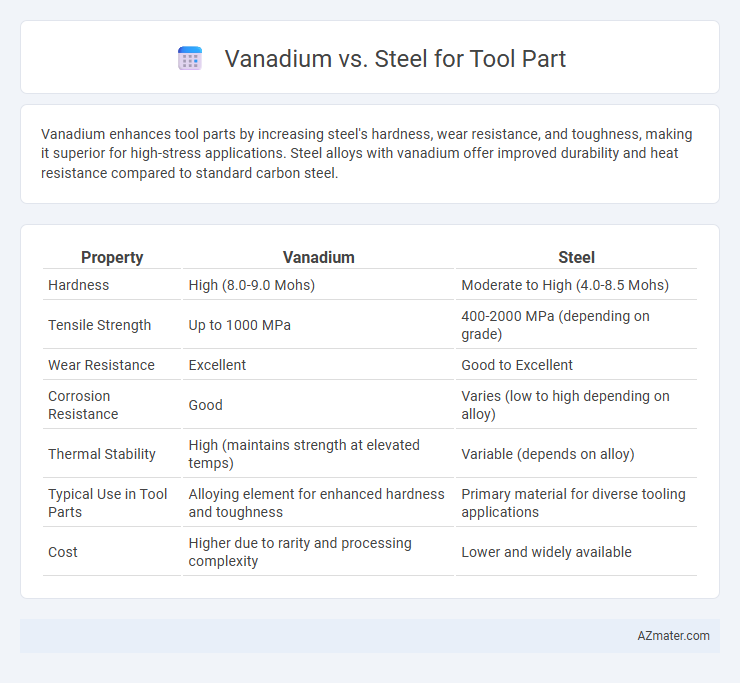Vanadium enhances tool parts by increasing steel's hardness, wear resistance, and toughness, making it superior for high-stress applications. Steel alloys with vanadium offer improved durability and heat resistance compared to standard carbon steel.
Table of Comparison
| Property | Vanadium | Steel |
|---|---|---|
| Hardness | High (8.0-9.0 Mohs) | Moderate to High (4.0-8.5 Mohs) |
| Tensile Strength | Up to 1000 MPa | 400-2000 MPa (depending on grade) |
| Wear Resistance | Excellent | Good to Excellent |
| Corrosion Resistance | Good | Varies (low to high depending on alloy) |
| Thermal Stability | High (maintains strength at elevated temps) | Variable (depends on alloy) |
| Typical Use in Tool Parts | Alloying element for enhanced hardness and toughness | Primary material for diverse tooling applications |
| Cost | Higher due to rarity and processing complexity | Lower and widely available |
Introduction to Vanadium and Steel in Tool Parts
Vanadium is a critical alloying element in tool steels, enhancing hardness, wear resistance, and toughness by refining grain size and forming stable carbides. Steel, primarily composed of iron and carbon, serves as the base material for most tools due to its strength, ductility, and adaptability to heat treatment processes. Vanadium-enriched steels outperform standard carbon steels in tool applications by providing superior edge retention and resistance to deformation under high-stress conditions.
Composition and Material Properties
Vanadium-enhanced tool steels contain precise amounts of vanadium, often between 0.1% to 0.3%, which significantly improves hardness, wear resistance, and toughness compared to conventional carbon steel compositions. The addition of vanadium forms stable carbides that refine grain structure, enhancing material strength and thermal stability critical for high-performance tool parts. Steel without vanadium generally exhibits lower resistance to abrasion and fatigue, making vanadium-alloyed steels the preferred choice for demanding industrial tool applications.
Strength and Durability Comparison
Vanadium significantly enhances the strength and durability of steel when used as an alloying element, resulting in tool parts with increased wear resistance and toughness. Vanadium steel alloys exhibit superior tensile strength and fatigue resistance compared to conventional carbon steels, making them ideal for high-stress applications. The microstructure refined by vanadium carbides contributes to improved hardness and long-lasting performance in demanding industrial tool components.
Hardness and Wear Resistance
Vanadium enhances steel's hardness and wear resistance by forming stable carbides that improve tool performance and lifespan. Steel alloys with vanadium exhibit superior hardness, typically ranging from 60 to 70 HRC, compared to standard carbon steels with lower wear resistance. This increased hardness directly translates to improved durability and reduced tool degradation in high-friction applications.
Corrosion Resistance Analysis
Vanadium alloys exhibit superior corrosion resistance compared to traditional steel, particularly in acidic and high-temperature environments, due to their stable oxide film formation on the surface. Steel tool parts often require coatings or treatments to enhance corrosion protection, whereas vanadium's inherent resistance reduces maintenance needs and prolongs tool lifespan. This advantage makes vanadium a preferred material in applications demanding durability against chemical degradation and oxidative wear.
Manufacturing and Machinability
Vanadium alloys offer superior hardness and wear resistance compared to traditional steel, making them ideal for high-performance tool parts in manufacturing. Vanadium enhances steel's grain refinement, improving machinability by reducing tool wear and enabling faster cutting speeds. Steel remains favored for its cost-effectiveness and versatility, but vanadium-infused steels provide a balance of strength and machinability essential for precision tool applications.
Cost and Availability
Vanadium-enhanced steel offers superior strength and wear resistance but typically comes at a higher cost due to the rarity and processing complexity of vanadium alloys. Standard steel remains more cost-effective and widely available, making it the preferred choice for mass-produced tool parts where budget constraints are critical. Supply chain considerations favor steel as vanadium's limited availability can lead to price volatility and procurement challenges in large-scale manufacturing.
Applications in Tool Parts
Vanadium enhances steel's hardness, wear resistance, and fatigue strength, making vanadium-alloyed steel essential for high-performance tool parts such as cutting tools, drill bits, and dies. Tool parts with vanadium steel exhibit superior edge retention and durability under extreme stress, outperforming conventional steel in demanding applications. This combination is widely used in automotive, aerospace, and manufacturing industries due to its balance of toughness and resistance to deformation.
Environmental Impact and Sustainability
Vanadium-enhanced steel tool parts significantly improve durability and wear resistance, reducing the frequency of replacements and lowering overall material consumption, which benefits sustainability. The extraction and processing of vanadium entail energy-intensive operations with notable carbon emissions, yet the extended lifespan of vanadium-alloyed tools offsets environmental costs by minimizing waste and resource use. Steel, while widely recyclable, generally requires more frequent replacement when used alone in tools, increasing environmental impact through energy use and raw material depletion over time.
Conclusion: Choosing the Right Material
Vanadium offers superior hardness, wear resistance, and fatigue strength compared to traditional steel, making it ideal for high-performance tool parts subjected to extreme conditions. Steel remains a cost-effective choice with good machinability and toughness for general-purpose tools where budget constraints are critical. Selecting between vanadium and steel ultimately depends on the required tool performance, application demands, and cost considerations to ensure durability and efficiency.

Infographic: Vanadium vs Steel for Tool Part
 azmater.com
azmater.com